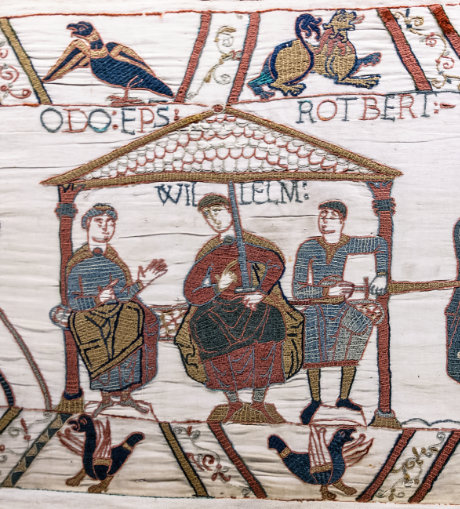William I Booklet
Write what you've learned about William the Conqueror in one of our little foldable booklets. You will need our origami booklet instructions.
&npsp;
William, Duke of Normandy and his Norman troops defeated an exhausted King Harold II at the Battle of Hastings in 1066, and conquered England, beginning a period of Norman rule. Learn about William the Conqueror with our fun facts and short biography for children, and enjoy our printable activities below.

A depiction of William I, William the Conqueror
“William the conqueror, long did reign. William his son, by an arrow was slain.”
William was the illegitimate son of Robert, Duke of Normandy. He inherited his father’s title when he was just nine years old, although many people at the time disagreed with this status.
In 1049, William married Matilda (a descendant of Alfred the Great). Although the Pope disapproved, the marriage was remarkably successful. While William was off fighting to expand his empire, Matilda stayed home to manage things. They also had at least nine children together.
The English Crown
William was a distant cousin of Edward the Confessor, who had promised him the crown (with the approval of the Pope). When Harold Godwinson was made king (Harold II) on Edward’s death in January 1066, William was determined to fight for his right to rule.
The Battle of Hastings
While Harold was busy defeating Harold Hardrada at the Battle of Stamford Bridge in September, William overcame reluctance from Norman nobles to invade, and was skilfully organising a strong army. They crossed the Channel in the cover of darkness and Harold’s army had to walk the long journey back to confront them. They met at the Battle of Hastings in October 1066, where William’s stronger army were victorious.

William the Conqueror (centre) as depicted on the Bayeux Tapestry
Influence on England
After his victory, William rode to London and gave himself a magnificent coronation at Westminster Abbey on Christmas Day. French became the official language of the King’s court and William replaced many lords with his own French advisers, including the Archbishop of Canterbury. Although many ordinary people objected, there was nothing they could do. William built many castle and had fierce soldiers who would burn people’s land and belongings if they disagreed.
William had very strict rules. Before his reign, men and women were treated almost equally. But now women had to obey their fathers (or their husbands if they were married). Murder became a punishable crime for the first time, and William banned slavery and the death penalty.
So that he could tax the citizens of his new kingdom William commissioned the Domesday Book, which was completed in 1086. It was a survey of all the estates, towns and villages in England at the time. It is very valuable to historians as it tells us where people lived and who owned what. The book was very unpopular with his people, however, who thought of it as the "day of doom"!
William's death - and a gruesome fact!
William visited England for the last time in 1086, a year before he died. He still ruled Normandy and the last year of his life was spent fighting against the French king and his eldest son Robert Curthose, who opposed him. During one battle at Mantes, William fell painfully against the pommel of his horse’s saddle. He injured his intestines badly and died a few weeks later. It was a while before William was buried. First all his belongings were stolen, then his funeral was interrupted by a fire. When the fire had been put out they found that his body did not fit into the coffin. When pushing him in, his stomach, which was swollen and filled with pus because of the injury, burst! Five hundred years later, during the French Revolution, his tomb at Caen was broken into and his bones scattere
William was succeeded by his second surviving son William Rufus, who became William II.
Write what you've learned about William the Conqueror in one of our little foldable booklets. You will need our origami booklet instructions.
Choose one of our two notebooking pages for your work on William I, better known as William the Conqueror.
Use these notebooking pages to capture what children are learning about William I, most commonly known as William the Conqueror. There are 4 pages in this pack, with various illustrations and different designs to choose from.
Children can use our William I story paper pages to write what they have learned about William the Conqueror. We've included pictures of his victory at the Battle of Hastings and the Domesday Book, as well as extra blank pages, in this 4-page pdf file.
William the Conqueror commissioned the Domesday Book so that he could find out all about his new country, England, and tax it correctly.
William, Duke of Normandy and his Norman troops defeating an exhausted Harold II at the Battle of Hastings, and conquered England, beginning a period of Norman rule. This colouring page depicts a victorious William the Conqueror after the battle.
William the Conqueror ruled form 1066 to 1087 and was the first of our Norman kings. Here's a fun colouring page based on his picture in the Bayeux Tapestry.
This is a 3-page printable version of the fun facts and short biography from our page on William I, William the Conqueror.